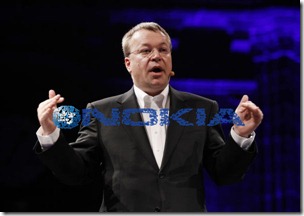Nokia, Microsoft, Stephen Elop & Uncertainties
Posted by RAMEEZ KAKAKHEL

11th February was the date when Nokia announced its partnership with Microsoft. It’s was just the last month but it already feels like an old story.
I thought the same until I picked up this month’s issue of the most reputed local internet magazine and was disappointed to read the same pre-calculated analysis published in it (which is circulating all over the web).
So let’s dissect & clarify this issue once and for all.
Let’s go couple of years back, when Nokia started losing its market share to iOS and Android and it strongly needed to come up with a competitive product but this time it was not about cutting edge hardware, but it was about the software and the user experience.
Nokia’s answer was not customized Symbian but Maemo which later turned into MeeGo, which was going to be the future of Nokia’s smartphones – but something didn’t go right.
During all this, iOS was advancing, Android was expanding its user base, HP bought Palm and released WebOS 2.0, RIM launched a new & improved version of its BlackBerry OS & a BlackBerry tablet, one company was left without an Eco System of their own & it was Nokia.
They had to act and act fast.
Now if we believe Nokia’s CEO Stephen Elop, he said in an interview that when he arrived at the company (Sep. 2010), Nokia then knew that it has to make a strategic assessment & CEO’s job was to lead the company through that.
At this point Nokia weighed all of its options from continued investment in Symbian to MeeGo to other platforms and finally partnered with Microsoft for Windows Phone 7.
You may argue why Nokia didn’t partner with Android then?
Here is the reason: Back in September 2010 Google asked Motorola to stop using SkyHook’s location services on the Droid X, which Motorola had decided to use instead of Google’s Location Services.
If Nokia was in place of Motorola (and considering the fact that Nokia owns Navteq (a $8.1 Billion acquisition)), it would never had nodded the Google’s call.
But now, look at the complete freedom Nokia has – it can modify Windows Phone 7 in any way it want. So definitely WP7 was the choice.
will Symbian Die after WP7 Phones?
So is Symbian dead? MeeGo gone? N-series phones soon to be history? The answer it not what you have been listening to and it is, No.
Symbian is staying in its current status till the end of 2012 and until than it will be actively developed and modified. One example is the new set of icons, animations, customizable widgets and the addition of my favorite feature, the drop down notification bar (yes, they way Andriod has it).
This update is coming soon.
What will happen after 2012? The Smartphone’s from Nokia will transition to Windows Phone 7 & Symbian (particularly Series 40 & variants) will continue to be a part of the low-end phones or plain mobile phones. So it is more of relegation than plain death. But where does MeeGo fit in?
“We are not thinking about MeeGo as the Plan B but we are thinking about MeeGo as what’s the next generation”, “What’s the next wave of business and technological disruption (beyond iOS, Android, WP7). We want to make sure we are leading through that as well”.
These three lines summarize the future of MeeGo as it is the OS Nokia will develop to lead the future platform/OS wars beyond the current ones.
What the future holds, no one knows for sure. Huawei is manufacturing low priced cheap Android phones, there are rumors that Apple is working on a smaller or cheaper iPhone & that too is the plan of Nokia to bring WP7 to all the different price points instead of just a premium product.
Whatever the outcome, one thing is for sure, the consumer (you & I) will benefit.
The post Nokia, Microsoft, Stephen Elop & Uncertainties appeared first on .



